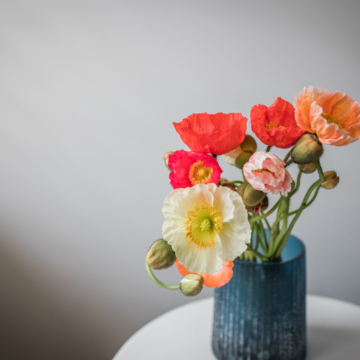It’s always fun walking through the flower market and picking a few handfuls of blooms for my weekend vase arrangements, but it’s important to know what to look for. After all, you don’t want to end up with a beautiful bouquet that only lasts a few days!
All flowers have different characteristics that will tell you how fresh they are, and your arrangements and cut flowers will last much longer if you use the freshest flowers and plant materials available to you.
When selecting flowers and foliage for maximum vase life, check the following.

Stems
You’ll want to select flowers with green stems and vivid foliage. Look out for any yellowing or slimy leaves––we definitely don’t want those! The stems should be stiff but supple, showing that the flowers are well hydrated.
Keep an eye out for damaged bunches or stems; holes or tears in leaves shorten their vase life as the damage can assist in attracting bacteria growth.

Buds
When flowers or buds are present, make sure the majority of the blooms are still closed. Buds that are open should be bright and fresh in appearance, so if they’re not, best to pass!
The buds should also not be transparent or have any protruding veins. If they do, it means that the flowers have been cold-stored for too long, which may result in the blooms failing to open at all. Transparent or veiny buds can also indicate that the flowers are dry.
Look for buds with a lot of colour present. Tight, colourless buds can often indicate that the blooms were cut prematurely––making them no good for your arrangement.

Petals
Look for flower petals with bright, vivid colours and make sure the veins in the petals and leaves are not visible (as previously mentioned) as this indicates they are drying out.
As flowers are natural materials, we need to be aware that not every flower we purchase will be without imperfections. However, knowing the signs of unhealthy flowers will help you a lot at the market to only pick flowers that will last.
If you’re a florist, you may sometimes receive stock from your wholesalers that needs to be returned. Don’t be afraid to do this––it’s your money and reputation at the end of the day! What can really help with minimising the likelihood of receiving poor-quality stock is building a solid relationship with your wholesalers and growers. This relationship will also make returning any sub-par flowers a lot easier.
For the budding florists among us, I talk a lot more about the signs of unhealthy flowers and how to deal with wholesalers in my Career Change Course. Enrol now and get your brand-new career underway!
Yvette x







